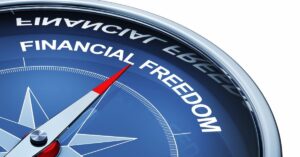Financial freedom isn’t just a dream, it’s a goal built on numbers, choices, and smart planning. At the heart of this pursuit lies your freedom number, the amount of income you need each month to live life on your terms, without relying on a 9-to-5. Knowing this number can turn a vague desire for independence into a concrete, achievable target.
In this article, you’ll learn what a freedom number is, why it matters, and how to calculate your own step-by-step. You’ll also uncover common myths that hold people back and discover practical strategies to reach your number faster.
Let’s break it down!
What Is Your Financial Freedom Number?
Your financial freedom number is the monthly income you need to cover all your living expenses without relying on a traditional job. It’s not a random figure, it’s a personal benchmark that reflects your lifestyle, goals, and financial priorities.
Objectively, it’s a simple equation: your essential expenses plus the cost of the life you want to live. Subjectively, it’s a reflection of what freedom means to you, whether it’s traveling the world, spending time with family, or pursuing passion projects without worrying about bills.
The power of your freedom number lies in its clarity. It transforms financial independence from a vague dream into a measurable goal. Some people chase a number that lets them live lavishly, while others aim for a lean figure that covers only the basics.
There’s no right answer, it’s about aligning your finances with your values. Understanding this number is the first step in taking control of your financial future, empowering you to create a strategy that funds your ideal life.
What Defines A Good Freedom Number?
A good freedom number is one that hits or exceeds 1.0, meaning your passive income fully covers your monthly expenses. At 1.0 or higher, you’re financially independent and can live without relying on active work or side hustles. It’s a sign you’ve built a strong money machine that runs without you.
A bad freedom number is anything below 1.0. It means your passive income isn’t enough to cover your lifestyle, forcing you to work, sell assets, or hustle harder. Falling short can leave you vulnerable to financial stress if your income streams dry up.
The goal isn’t just to reach 1.0, it’s to surpass it. Crossing that line gives you breathing room, protects you from setbacks, and allows you to choose how you spend your time. That’s real freedom.
How To Calculate Your Freedom Number (With/Out A Finance Degree)
1. List Your Monthly Essentials (The Non-Negotiables)
Identify the core expenses that keep your life running. This includes housing, utilities, groceries, transportation, and insurance. Essentials are your baseline—the minimum you need for a stable life. Keeping these numbers accurate is key to building a realistic freedom number.
Once you have these totals, you’ll see your baseline monthly cost of living. Knowing this figure is vital, as it forms the foundation of your financial freedom number. Essentials may seem like survival costs, but they represent the true minimum needed to maintain your current lifestyle.
2. Add Your Desired Lifestyle Costs (Because Freedom Should Be Fun)
Financial freedom isn’t just about surviving, it’s about living life to the fullest. Add expenses that define your lifestyle, such as travel, hobbies, dining out, and entertainment. Be clear on what matters most to you because these costs shape your version of freedom.
Accurately calculating lifestyle costs prevents underestimating what your dream life truly costs. It’s not about inflating numbers; it’s about honesty. Combining these with your essentials gives you a complete view of what living life on your terms requires.
3. Account for Taxes (Because the IRS Always Shows Up)
Your freedom number should reflect your after-tax income needs. Estimate how much you’ll owe based on your income sources. For instance, passive income from investments may be taxed differently than regular employment.
Without accounting for taxes, your freedom number will be short of reality. Build in a cushion for state, federal, and self-employment taxes. This step ensures that your number represents what you keep, not just what you earn.
4. Factor in Health Insurance and Emergency Savings (Plan for Life’s Curveballs)
True financial freedom requires protection from life’s uncertainties. Include health insurance premiums and plan for unexpected expenses with an emergency fund. These two elements create a buffer that keeps your freedom intact during hard times.
Emergency savings should cover at least three to six months of living expenses. Without these safety nets, a sudden setback could force you back into the rat race. Securing your freedom means protecting it from surprises.
5. Subtract Passive Income or Investments (Let Your Money Do the Work)
Identify any income streams that reduce how much you need to earn actively. This could be from rental properties, stock dividends, or a side business. Passive income is a freedom number shortcut, it lowers your target by doing the heavy lifting for you.
Subtract your passive earnings from your total monthly expenses. If your expenses are $5,000 per month and you earn $2,000 passively, your freedom number drops to $3,000. Passive income directly reduces the time and effort required to reach independence.
6. Find Your Final Freedom Number (The Goal That Changes Everything)
Sum your essentials, lifestyle costs, taxes, and safety nets, then subtract your passive income. The final number is your personal financial freedom number, the monthly amount needed to live life on your terms.
This number isn’t just a target; it’s your roadmap. Knowing it gives your financial strategy a clear direction. With it, you’ll focus on building income streams that bring you closer to your goal every day.
Freedom Number Calculation Example
Let’s paint a picture: Imagine you’re tired of the 9-to-5 grind and dream of living life on your terms. You don’t want to work forever, you want your money to work for you. This is where knowing your freedom number turns your dream into a plan.
It’s not guesswork or wishful thinking; it’s a concrete number based on your lifestyle and choices. To make it real, let’s walk through an example and see how the numbers add up.
Meet Sarah, a 35-year-old graphic designer with a side hustle and a passion for travel. She calculates her monthly essentials: $1,500 for rent, $300 for utilities, $600 for groceries, $400 for insurance, and $200 for transportation.
That totals $3,000 for basic needs. Adding her lifestyle costs, $500 for dining, $300 for hobbies, and $200 for travel savings, brings her monthly total to $4,000. She estimates $800 for taxes and saves $300 toward an emergency fund, making her target $5,100.
Now, Sarah factors in her passive income. She earns $1,000 per month from a rental property and $500 from stock dividends. Combined, that’s $1,500 off her monthly total. Subtracting this from her $5,100 target leaves her with a freedom number of $3,600 per month.
This means if she earns $3,600 monthly through her side hustle or investments, she’s financially free. Sarah’s example shows that financial freedom isn’t about being rich, it’s about knowing your number and building a life that funds itself.
Levels Of Financial Success
1. Financial Stability (The Starting Line)
This is where you can comfortably cover your basic expenses and have a small emergency fund. You’re no longer living paycheck to paycheck, but you still rely on your active income. It’s a solid foundation, but not quite freedom, yet.
2. Financial Security (The Safety Net)
At this level, your passive income covers your essentials, housing, food, and utilities. You could survive without working, but only at a basic standard of living. It’s peace of mind, but you’re still not living life on your terms.
3. Financial Independence (The Freedom Zone)
Your passive income fully covers both your needs and your desired lifestyle. Work becomes a choice, not a necessity. This is where your freedom number lives, the sweet spot where life is yours to design.
4. Financial Abundance (The Overflow)
Your income exceeds your lifestyle costs, allowing you to save, invest, and give generously. You have more money than you need, opening doors to bigger dreams and opportunities. It’s about impact, legacy, and living without limits.
5. Financial Legacy (The Endgame)
You’ve built wealth that outlasts you, enough to support future generations or causes you care about. Your money continues to grow and create impact without your involvement. This isn’t just success, it’s significance.
Freedom Number: Final Words
Your freedom number isn’t just a calculation, it’s a blueprint for living life on your terms. By understanding your expenses, factoring in passive income, and setting realistic goals, you transform financial independence from a dream into a plan.
True freedom isn’t just about reaching the number, it’s about surpassing it and building a life that offers security, choice, and lasting impact.
Frequently Asked Questions
How often should I update my freedom number?
Review your freedom number at least once a year or when your financial situation changes. Life events like a new job, marriage, or a large investment can shift your expenses and passive income, affecting your target number.
Can my freedom number change over time?
Yes, your freedom number evolves with your lifestyle, goals, and market conditions. Rising costs, new investments, or a shift in priorities can increase or decrease your target, so it’s important to reassess regularly and adjust your plan accordingly.
Is having multiple income streams necessary to reach my freedom number?
Multiple income streams, especially passive ones, can accelerate your journey to your freedom number. While not required, they reduce risk, provide stability, and help you reach your goal faster by covering more of your monthly expenses automatically.
Related:
- How To Turn Your Life Around: Practical Tips For Success
- The 3 A Strategy: The Process Behind Everyone’s Success
- Innovative Entrepreneur: Key Traits and Tips for Success

We empower people to succeed through information and essential services. Do you need help with something? Contact Us.
Want a heads-up once a week whenever a new article drops?







